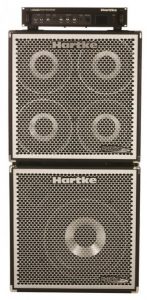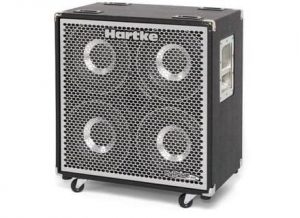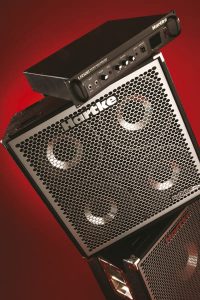Hartke made its name with aluminium speakers, then offered paper ones, and now are back with both in the same package. Gareth Morgan finds out what’s going on. Hartke built its first cabinet specifically for the late, great Jaco Pastorius in 1984. But the company’s probably most famous for the later use of aluminium-coned speakers Hartke LH500 Head. Hartke chose aluminium as they found that it produced a wider frequency range than conventional drivers due to a faster transient response.

Many bass players instantly loved the quicker attack and clearer tone. The last piece of Hartke kit we examined, the VX2510 combo reviewed in our April 2007 issue (Vol 18/3), eschewed the use of aluminium cones for the traditional paper variety. We’re happy to report that they make a welcome return here, albeit in modified form, courtesy of the new HyDrive cabinets currently on the reviewing bench alongside the equally new LH500 head.
Features Hartke LH500 Head
Table of Contents
The rugged Chinese-made Hartke LH500 Head head spits out a crunching 500W of Class A power and has a single 12AX7 valve in the preamp stage. It’s housed in a two-rackspace metal box with a steel face-plate and steel handles. Weighing in at a manageable 10.5kg/23lbs it sits on four chunky rubber feet to ensure it won’t etch its presence into your cabs. Should you choose to simply plonk it on top instead of using it with a rack.
On the controls front, the Hartke LH500 Head couldn’t be simpler. Alongside Volume, there’s a three-band EQ that Hartke describe as a ‘tone stack’ system. We couldn’t extract any information as to levels of boost in dB but we were informed that each control represents a frequency range and that the different controls ‘feed into each other’. Some of the information provided is a little confusing; for example, Hartke says that with Bass at 0, ‘the Mid control pretty much boosts all frequencies’. Which surely, in this mode, makes it a global boost control?

Anyway, disinformation aside, the EQ section is boost-only and apparently ‘really musical’ and ‘simple to use’. There’s also a Brite switch with an amber ‘On’ LED which boosts ‘high-end frequency response’. And some protection is provided by the onboard limiter which you can switch in and out. A blue LED tells you when it’s active.
Pros and Cons
As well as Passive and Active jack sockets and an XLR DI Out on the front panel. You’ll find two Speaker Outs and an FX loop on the back, all of the jack variety. The FX Send jack can also be used as an additional line-out feed to a mixing desk or secondary amplifier. There’s also a section of square black sponge next to the Power switch which is a filter covering the amplifier’s cooling tunnel vent. It can be easily removed and cleaned when it gets clogged up by the dusty environments that most musicians seem to operate in.
Both the cabinets are Chinese-made, and come loaded with Hartke’s new HyDrive Neodymium hybrid cone speakers – one 500W 15″ in a ported 17mm plywood cab (HX115) and four 250W 10″ units in a sealed, two-chamber box (the HX410). ‘Hybrid’ refers to the fact that the outer sections of the cones are formed from traditional paper while the inners are aluminium. A combination which Hartke says produces warm, deep lows and cutting but ‘sweet’ mids and highs. They also say that a Neodymium HyDrive speaker weighs 40 per cent less than traditional units and operates at cooler temperatures, thus delivering ‘more reliable power handling at peak performance’.

We’re salivating at the prospect of plugging in, but before we do there are a few more details worth knowing. Both cabs stand 625mm high on their rubber feet, 611mm wide and 381mm deep. With the 115 weighing in at a highly reasonable 28kg/61lbs and the 410 an acceptable 32kg/70lbs. The speakers are protected by steel grilles which sport the chunky logo along their top edge. And a more reserved model name in the bottom right-hand corner. The cabs are dressed in black vinyl with steel corners and recessed handles. And as castors are supplied as standard, lugging and shoving shouldn’t be too much of a chore. While both cabs are tweeter-loaded. They’ve also got an On/Off/-6dB switch on the back alongside two In/Link jack sockets and two more of the Speakon variety for the same purpose.
Sounds HyDrive HX115
After carefully checking out the rig with varying degrees of horn switched in, we switched both to ‘off’ for a couple of reasons. First, the aluminium element in the speakers makes them fast enough to produce enough treble response for even the clickiest slap. And secondly, in fingerstyle mode the HD cabs are already spitting out audible finger-noise and fret-noise. And the horns only make it worse.

Other than that, you’ll find the LH/HD rig monstrously loud but refreshingly clean at stadium-shaking levels. Although dialling in sounds is a strange experience given the quirky nature of the EQ. Even though the amp is ‘boost only’, chopping everything back to zero gets you silence. So we set the controls to the traditional central position, in this case 5 on the dial. This produces a crunching full-range tone with snarling lows, clean, even mids and fat, biting highs. A perfect sound for full-range fingerstyle in a variety of styles. You might want to engage Brite switch for slap but this induces lots of fret noise on thinner strings. And with Brite on, and the tweeters at -6dB you’ve got the clankiest, most metallic tone the world has ever heard. It’s easy to get it clean, though, and easy to make loads of noise.
Cranking Bass right up is stomach-churning, but with wonderfully clean definition. Adding Mid is akin to going 15 rounds with the hardest-punching fighter of all time. And upping the Treble really takes your head off. For a burpier sound, nudge the Bass knob to around 2 or 3. Mid between 6 and 10 and Treble anywhere from 3 to 6. This gives a mild but very funky honking edge with warm lows plus clean. Even highs that gives this variation a versatile pop/funk sound great fun to groove with.
Verdict Hartke LH500 Head
First, the downsides. Hartke seems to have made Hartke LH500 Head EQ section intentionally confusing and idiosyncratic. And just under 1600 is a hefty investment to make, especially for amateur or even semi-pro players. However, once you get into a little experimentation with the EQ and check out what level of tweeter involvement. If any, works for your style and requirements, there’s loads of good stuff in this rig. It’ll effortlessly do polite or dirty, funky or rocky. And all with oceans of volume and power to spare (and there’s a 1000W version of the head if you really want to make the front rows of your audience suffer). The LH/HD rig is bulky. Then again, two-cab set ups always are it’s the quality and variety of noise they make that’s important. In this instance, it’s undeniably top-notch.

Leave a Reply
You must be logged in to post a comment.